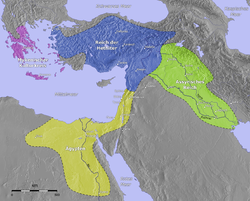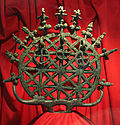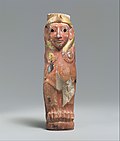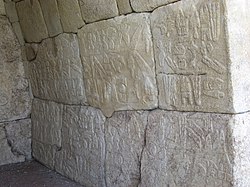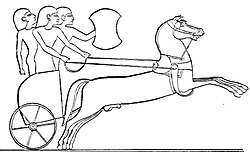Hittites

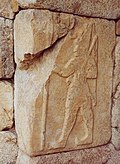
The Hittites were an ancient people from Anatolia who spoke an Indo-European language that they wrote with cuneiform script. They established a kingdom centered on Hattusha, in north-central Anatolia, from the 18th century BC.
At its peak, the Hittite Empire covered most of modern Turkey and Syria, under the reigns of Suppiluliuma I (~1350–1322) and Mursili II (~1321–1295 BC). They had up-and-down relationships with the New Kingdom of Egypt to the south and the Assyrian Empire in Mesopotamia. They were a party to the first known peace treaty, made with Ramesses II of Egypt by Hattusili III in 1258 BC.
After 1180 BC, the empire disintegrated into several independent "Neo-Hittite" city-states, some surviving until as late as the 8th century BC.
Empire of Suppiluliuma and Mursili II
The Hittite Empire reached its zenith during the reign of Suppiluliuma I (~1350–1322).[2] The Kingdom of Mitanni, wracked by civil war, was unable to withstand the Hittite onslaught. Suppiluliuma swiftly attacked the Mitanni heartland and captured and plundered the Mitanni capital of Washshuganni. He then turned west, recrossed the Euphrates and captured all of the Syrian kingdoms that were vassals to the Mitanni, including Aleppo, Mukish, Niya, Qatna, Upi (Upina), and Kadesh. Other kingdoms such as Ugarit and Amurru (an Egyptian vassal) voluntarily became vassal states of the Hittites.[2]
When hostilities flared up once more with Mitanni, Tulipinu, Suppiluliuma's son and viceroy at Aleppo, invaded Carchemish but was unable to take the city. Suppiluliuma met with his son, invaded Syria himself, and lay siege to the city of Carchemish. Suppiluliuma broke the siege on the eighth day ansd installed his son Piyassili as viceroy of the kingdom. With his sons as viceroys of Aleppo and Carchemish, Suppiluliuma had cemented his rule over Syria and brought the kingdom to an end. The Mitanni King was soon assassinated.[2]
The murdered prince
When Tutankhamun, the Egyptian Pharaoh, died, his widow asked to marry one of Suppiluliuma's sons. He agreed and sent his son Zannanza to Egypt to marry the queen. However, Zannanza was assassinated en route to Egypt.
Suppiluliuma was furious and blamed the new Egyptian Pharaoh Ay for his son's death. A Hittite army under Crown Prince Arnuwanda invaded Egyptian territory from Syria, did pillage and took many prisoners. The prisoners brought with them a plague, which ravaged the Hittite Kingdom and continued well into Mursili's reign and may have killed Suppiluliuma himself.[2]
Mursili II
Mursili II was young and inexperienced, but he proved to be a strong king. In the first years of his reign, he carried out punitive campaigns against several kingdoms. In Syria, Nuhashshi King Tette rebelled and was joined by Egyptian troops. Troubles in Syria continued when both of Mursili's brothers (Tulipinu and Piyassili) died. The loss of his Syrian viceroys led to rebellion and even the invasion of Carchemish by Assyria.
Leaving his generals to deal with Syria and Haysa, Mursili invaded Carchemish and drove out the Assyrians.[2] Later in his reign, Mursili campaigned against the Kaska and once again retooj the Hittite holy city of Niniveh. He also decisively defeated the King of Tummanna.
Hittites Media
The Great Temple in the inner city of Hattusa
An Alaca Höyük bronze standard from a third millennium BC pre-Hittite tomb (Museum of Anatolian Civilizations, Ankara)
Drinking cup in the shape of a fist; 1400–1380 BC, Museum of Fine Arts, Boston
Ceremonial vessels in the shape of sacred bulls, called Hurri (Day) and Seri (Night) found in Hattusa, Hittite Old Kingdom (16th century BC) Museum of Anatolian Civilizations, Ankara
The Sphinx Gate (Alaca Höyük, Çorum, Turkey)
Other websites
| Wikimedia Commons has media related to Lua error in Module:Commons_link at line 62: attempt to index field 'wikibase' (a nil value).. |
- Hattusas/Bogazköy Archived 2009-06-30 at the Wayback Machine
- The Hittite Home Page Archived 2009-11-15 at the Wayback Machine
- Arzawa, to the west, throws light on Hittites Archived 2004-02-02 at the Wayback Machine
- Pictures of Boğazköy, one of a group of important sites
- Pictures of Yazılıkaya, one of a group of important sites
- Pictures of Alacahöyük, one of a group of important sites
- Der Anitta Text (at TITUS)
- Encyclopaedia of Turkey : Hittite relief at Karabel Archived 2008-05-30 at the Wayback Machine
- Tahsin Ozguc Archived 2007-03-01 at the Wayback Machine
- Hittites.info
- Hittite Period in Anatolia
- pictures Archived 2008-04-11 at the Wayback Machine
- Hethitologieportal Mainz, by the Akademie der Wissenschaften, Mainz, corpus of texts and extensive bibliographies on all things Hittite
References
- ↑ Data from Open Genomes and Damgaard et al. 2018; Map colouring: Casippo Open Genomes
- ↑ 2.0 2.1 2.2 2.3 2.4 Trevor R. Bryce 2005. The Kingdom of the Hittites.
